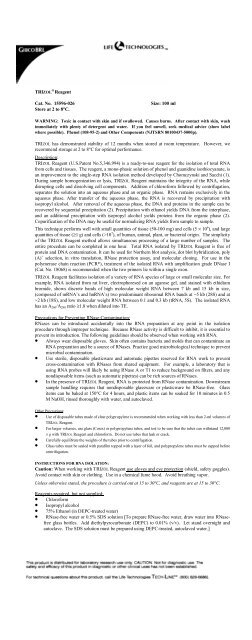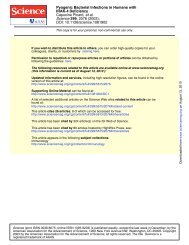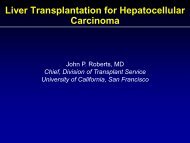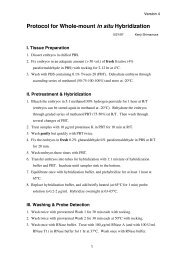TRIZOL® Reagent Cat. No. 15596-026 Size: 100 ml Store at 2 to 8 ...
TRIZOL® Reagent Cat. No. 15596-026 Size: 100 ml Store at 2 to 8 ...
TRIZOL® Reagent Cat. No. 15596-026 Size: 100 ml Store at 2 to 8 ...
You also want an ePaper? Increase the reach of your titles
YUMPU automatically turns print PDFs into web optimized ePapers that Google loves.
TRIZOL ® <strong>Reagent</strong><strong>C<strong>at</strong></strong>. <strong>No</strong>. <strong>15596</strong>-<strong>026</strong><strong>S<strong>to</strong>re</strong> <strong>at</strong> 2 <strong>to</strong> 8°C.<strong>Size</strong>: <strong>100</strong> <strong>ml</strong>WARNING: Toxic in contact with skin and if swallowed. Causes burns. After contact with skin, washimmedi<strong>at</strong>ely with plenty of detergent and w<strong>at</strong>er. If you feel unwell, seek medical advice (show labelwhere possible). Phenol (108-95-2) and Other Components (NJTSRN 80<strong>100</strong>437-5000p).TRIZOL has demonstr<strong>at</strong>ed stability of 12 months when s<strong>to</strong>red <strong>at</strong> room temper<strong>at</strong>ure. However, werecommend s<strong>to</strong>rage <strong>at</strong> 2 <strong>to</strong> 8°C for optimal performance.Description:TRIZOL <strong>Reagent</strong> (U.S.P<strong>at</strong>ent <strong>No</strong>.5,346,994) is a ready-<strong>to</strong>-use reagent for the isol<strong>at</strong>ion of <strong>to</strong>tal RNAfrom cells and tissues. The reagent, a mono-phasic solution of phenol and guanidine isothiocyan<strong>at</strong>e, isan improvement <strong>to</strong> the single-step RNA isol<strong>at</strong>ion method developed by Chomczynski and Sacchi (1).During sample homogeniz<strong>at</strong>ion or lysis, TRIZOL <strong>Reagent</strong> maintains the integrity of the RNA, whiledisrupting cells and dissolving cell components. Addition of chloroform followed by centrifug<strong>at</strong>ion,separ<strong>at</strong>es the solution in<strong>to</strong> an aqueous phase and an organic phase. RNA remains exclusively in theaqueous phase. After transfer of the aqueous phase, the RNA is recovered by precipit<strong>at</strong>ion withisopropyl alcohol. After removal of the aqueous phase, the DNA and proteins in the sample can berecovered by sequential precipit<strong>at</strong>ion (2). Precipit<strong>at</strong>ion with ethanol yields DNA from the interphase,and an additional precipit<strong>at</strong>ion with isopropyl alcohol yields proteins from the organic phase (2).Copurific<strong>at</strong>ion of the DNA may be useful for normalizing RNA yields from sample <strong>to</strong> sample.This technique performs well with small quantities of tissue (50-<strong>100</strong> mg) and cells (5 × 10 6 ), and largequantities of tissue (≥1 g) and cells (>10 7 ), of human, animal, plant, or bacterial origin. The simplicityof the TRIZOL <strong>Reagent</strong> method allows simultaneous processing of a large number of samples. Theentire procedure can be completed in one hour. Total RNA isol<strong>at</strong>ed by TRIZOL <strong>Reagent</strong> is free ofprotein and DNA contamin<strong>at</strong>ion. It can be used for <strong>No</strong>rthern blot analysis, dot blot hybridiz<strong>at</strong>ion, poly(A) + selection, in vitro transl<strong>at</strong>ion, RNase protection assay, and molecular cloning. For use in thepolymerase chain reaction (PCR*), tre<strong>at</strong>ment of the isol<strong>at</strong>ed RNA with amplific<strong>at</strong>ion grade DNase I(<strong>C<strong>at</strong></strong>. <strong>No</strong>. 18068) is recommended when the two primers lie within a single exon.TRIZOL <strong>Reagent</strong> facilit<strong>at</strong>es isol<strong>at</strong>ion of a variety of RNA species of large or small molecular size. Forexample, RNA isol<strong>at</strong>ed from r<strong>at</strong> liver, electrophoresed on an agarose gel, and stained with ethidiumbromide, shows discrete bands of high molecular weight RNA between 7 kb and 15 kb in size,(composed of mRNA’s and hnRNA’s) two predominant ribosomal RNA bands <strong>at</strong> ~5 kb (28S) and <strong>at</strong>~2 kb (18S), and low molecular weight RNA between 0.1 and 0.3 kb (tRNA, 5S). The isol<strong>at</strong>ed RNAhas an A260/A280 r<strong>at</strong>io ≥1.8 when diluted in<strong>to</strong> TE.Precautions for Preventing RNase Contamin<strong>at</strong>ion:RNases can be introduced accidentally in<strong>to</strong> the RNA prepar<strong>at</strong>ion <strong>at</strong> any point in the isol<strong>at</strong>ionprocedure through improper technique. Because RNase activity is difficult <strong>to</strong> inhibit, it is essential <strong>to</strong>prevent its introduction. The following guidelines should be observed when working with RNA.• Always wear disposable gloves. Skin often contains bacteria and molds th<strong>at</strong> can contamin<strong>at</strong>e anRNA prepar<strong>at</strong>ion and be a source of RNases. Practice good microbiological technique <strong>to</strong> preventmicrobial contamin<strong>at</strong>ion.• Use sterile, disposable plasticware and au<strong>to</strong>m<strong>at</strong>ic pipettes reserved for RNA work <strong>to</strong> preventcross-contamin<strong>at</strong>ion with RNases from shared equipment. For example, a labor<strong>at</strong>ory th<strong>at</strong> isusing RNA probes will likely be using RNase A or T1 <strong>to</strong> reduce background on filters, and anynondisposable items (such as au<strong>to</strong>m<strong>at</strong>ic pipettes) can be rich sources of RNases.• In the presence of TRIZOL <strong>Reagent</strong>, RNA is protected from RNase contamin<strong>at</strong>ion. Downstreamsample handling requires th<strong>at</strong> nondisposable glassware or plasticware be RNase-free. Glassitems can be baked <strong>at</strong> 150°C for 4 hours, and plastic items can be soaked for 10 minutes in 0.5M NaOH, rinsed thoroughly with w<strong>at</strong>er, and au<strong>to</strong>claved.Other Precautions:• Use of disposable tubes made of clear polypropylene is recommended when working with less than 2-<strong>ml</strong> volumes ofTRIZOL <strong>Reagent</strong>.• For larger volumes, use glass (Corex) or polypropylene tubes, and test <strong>to</strong> be sure th<strong>at</strong> the tubes can withstand 12,000× g with TRIZOL <strong>Reagent</strong> and chloroform. Do not use tubes th<strong>at</strong> leak or crack.• Carefully equilibr<strong>at</strong>e the weights of the tubes prior <strong>to</strong> centrifug<strong>at</strong>ion.• Glass tubes must be sealed with parafilm <strong>to</strong>pped with a layer of foil, and polypropylene tubes must be capped beforecentrifug<strong>at</strong>ion.INSTRUCTIONS FOR RNA ISOLATION:Caution: When working with TRIZOL <strong>Reagent</strong> use gloves and eye protection (shield, safety goggles).Avoid contact with skin or clothing. Use in a chemical fume hood. Avoid bre<strong>at</strong>hing vapor.Unless otherwise st<strong>at</strong>ed, the procedure is carried out <strong>at</strong> 15 <strong>to</strong> 30°C, and reagents are <strong>at</strong> 15 <strong>to</strong> 30°C.<strong>Reagent</strong>s required, but not supplied:• Chloroform• Isopropyl alcohol• 75% Ethanol (in DEPC-tre<strong>at</strong>ed w<strong>at</strong>er)• RNase-free w<strong>at</strong>er or 0.5% SDS solution [To prepare RNase-free w<strong>at</strong>er, draw w<strong>at</strong>er in<strong>to</strong> RNasefreeglass bottles. Add diethylpyrocarbon<strong>at</strong>e (DEPC) <strong>to</strong> 0.01% (v/v). Let stand overnight andau<strong>to</strong>clave. The SDS solution must be prepared using DEPC-tre<strong>at</strong>ed, au<strong>to</strong>claved w<strong>at</strong>er.]
1. HOMOGENIZATION (see notes 1-3)a. TissuesHomogenize tissue samples in 1 <strong>ml</strong> of TRIZOL <strong>Reagent</strong> per 50-<strong>100</strong> mg of tissue using aglass-Teflon ® or power homogenizer (Polytron, or Tekmar's TISSUMIZER ® orequivalent). The sample volume should not exceed 10% of the volume of TRIZOL<strong>Reagent</strong> used for homogeniz<strong>at</strong>ion.b. Cells Grown in MonolayerLyse cells directly in a culture dish by adding 1 <strong>ml</strong> of TRIZOL <strong>Reagent</strong> <strong>to</strong> a 3.5 cmdiameter dish, and passing the cell lys<strong>at</strong>e several times through a pipette. The amount ofTRIZOL <strong>Reagent</strong> added is based on the area of the culture dish (1 <strong>ml</strong> per 10 cm 2 ) and no<strong>to</strong>n the number of cells present. An insufficient amount of TRIZOL <strong>Reagent</strong> may result incontamin<strong>at</strong>ion of the isol<strong>at</strong>ed RNA with DNA.c. Cells Grown in SuspensionPellet cells by centrifug<strong>at</strong>ion. Lyse cells in TRIZOL <strong>Reagent</strong> by repetitive pipetting. Use1 <strong>ml</strong> of the reagent per 5-10 × 10 6 of animal, plant or yeast cells, or per 1 × 10 7 bacterialcells. Washing cells before addition of TRIZOL <strong>Reagent</strong> should be avoided as thisincreases the possibility of mRNA degrad<strong>at</strong>ion. Disruption of some yeast and bacterialcells may require the use of a homogenizer.OPTIONAL: An additional isol<strong>at</strong>ion step may be required for samples with high conten<strong>to</strong>f proteins, f<strong>at</strong>, polysaccharides or extracellular m<strong>at</strong>erial such as muscles, f<strong>at</strong> tissue, andtuberous parts of plants. Following homogeniz<strong>at</strong>ion, remove insoluble m<strong>at</strong>erial from thehomogen<strong>at</strong>e by centrifug<strong>at</strong>ion <strong>at</strong> 12,000 × g for 10 minutes <strong>at</strong> 2 <strong>to</strong> 8°C. The resulting pelletcontains extracellular membranes, polysaccharides, and high molecular weight DNA,while the supern<strong>at</strong>ant contains RNA. In samples from f<strong>at</strong> tissue, an excess of f<strong>at</strong> collects asa <strong>to</strong>p layer which should be removed. In each case, transfer the cleared homogen<strong>at</strong>esolution <strong>to</strong> a fresh tube and proceed with chloroform addition and phase separ<strong>at</strong>ion asdescribed.2. PHASE SEPARATIONIncub<strong>at</strong>e the homogenized samples for 5 minutes <strong>at</strong> 15 <strong>to</strong> 30°C <strong>to</strong> permit the completedissoci<strong>at</strong>ion of nucleoprotein complexes. Add 0.2 <strong>ml</strong> of chloroform per 1 <strong>ml</strong> of TRIZOL<strong>Reagent</strong>. Cap sample tubes securely. Shake tubes vigorously by hand for 15 seconds andincub<strong>at</strong>e them <strong>at</strong> 15 <strong>to</strong> 30°C for 2 <strong>to</strong> 3 minutes. Centrifuge the samples <strong>at</strong> no more than 12,000× g for 15 minutes <strong>at</strong> 2 <strong>to</strong> 8°C. Following centrifug<strong>at</strong>ion, the mixture separ<strong>at</strong>es in<strong>to</strong> a lower red,phenol-chloroform phase, an interphase, and a colorless upper aqueous phase. RNA remainsexclusively in the aqueous phase. The volume of the aqueous phase is about 60% of the volumeof TRIZOL <strong>Reagent</strong> used for homogeniz<strong>at</strong>ion.3. RNA PRECIPITATIONTransfer the aqueous phase <strong>to</strong> a fresh tube, and save the organic phase if isol<strong>at</strong>ion of DNA orprotein is desired. Precipit<strong>at</strong>e the RNA from the aqueous phase by mixing with isopropylalcohol. Use 0.5 <strong>ml</strong> of isopropyl alcohol per 1 <strong>ml</strong> of TRIZOL <strong>Reagent</strong> used for the initialhomogeniz<strong>at</strong>ion. Incub<strong>at</strong>e samples <strong>at</strong> 15 <strong>to</strong> 30°C for 10 minutes and centrifuge <strong>at</strong> no more than12,000 × g for 10 minutes <strong>at</strong> 2 <strong>to</strong> 8°C. The RNA precipit<strong>at</strong>e, often invisible beforecentrifug<strong>at</strong>ion, forms a gel-like pellet on the side and bot<strong>to</strong>m of the tube.4. RNA WASHRemove the supern<strong>at</strong>ant. Wash the RNA pellet once with 75% ethanol, adding <strong>at</strong> least 1 <strong>ml</strong> of75% ethanol per 1 <strong>ml</strong> of TRIZOL <strong>Reagent</strong> used for the initial homogeniz<strong>at</strong>ion. Mix the sampleby vortexing and centrifuge <strong>at</strong> no more than 7,500 × g for 5 minutes <strong>at</strong> 2 <strong>to</strong> 8°C.5. REDISSOLVING THE RNAAt the end of the procedure, briefly dry the RNA pellet (air-dry or vacuum-dry for 5-10minutes). Do not dry the RNA by centrifug<strong>at</strong>ion under vacuum. It is important not <strong>to</strong> let theRNA pellet dry completely as this will gre<strong>at</strong>ly decrease its solubility. Partially dissolved RNAsamples have an A260/280 r<strong>at</strong>io < 1.6. Dissolve RNA in RNase-free w<strong>at</strong>er or 0.5% SDS solutionby passing the solution a few times through a pipette tip, and incub<strong>at</strong>ing for 10 minutes <strong>at</strong> 55 <strong>to</strong>60°C. (Avoid SDS when RNA will be used in subsequent enzym<strong>at</strong>ic reactions.) RNA can alsobe redissolved in <strong>100</strong>% formamide (deionized) and s<strong>to</strong>red <strong>at</strong> -70°C (5).RNA Isol<strong>at</strong>ion <strong>No</strong>tes:1. Isol<strong>at</strong>ion of RNA from small quantities of tissue (1 <strong>to</strong> 10 mg) or Cell (10 2 <strong>to</strong> 10 4 )Samples: Add 800 µl of TRIZOL <strong>to</strong> the tissue or cells. Following sample lysis, addchloroform and proceed with the phase separ<strong>at</strong>ion as described in step 2. Prior <strong>to</strong>precipit<strong>at</strong>ing the RNA with isopropyl alcohol, add 5-10 µg RNase-free glycogen (<strong>C<strong>at</strong></strong>.<strong>No</strong> 10814) as carrier <strong>to</strong> the aqueous phase. To reduce viscosity, shear the genomicDNA with 2 passes through a 26 gauge needle prior <strong>to</strong> chloroform addition. Theglycogen remains in the aqueous phase and is co-precipit<strong>at</strong>ed with the RNA. It doesnot inhibit first-strand synthesis <strong>at</strong> concentr<strong>at</strong>ions up <strong>to</strong> 4 mg/<strong>ml</strong> and does not inhibitPCR.2. After homogeniz<strong>at</strong>ion and before addition of chloroform, samples can be s<strong>to</strong>red <strong>at</strong> -60 <strong>to</strong>-70°C for <strong>at</strong> least one month. The RNA precipit<strong>at</strong>e (step 4, RNA WASH) can be s<strong>to</strong>redin 75% ethanol <strong>at</strong> 2 <strong>to</strong> 8°C for <strong>at</strong> least one week, or <strong>at</strong> least one year <strong>at</strong> –5 <strong>to</strong> -20°C.3. Table-<strong>to</strong>p centrifuges th<strong>at</strong> can <strong>at</strong>tain a maximum of 2,600 × g are suitable for use in thesepro<strong>to</strong>cols if the centrifug<strong>at</strong>ion time is increased <strong>to</strong> 30-60 minutes in steps 2 and 3.INSTRUCTIONS FOR DNA ISOLATION:After complete removal of the aqueous phase, as described in the RNA isol<strong>at</strong>ion pro<strong>to</strong>col, theDNA in the interphase and phenol phase from the initial homogen<strong>at</strong>e may be isol<strong>at</strong>ed.Following precipit<strong>at</strong>ion and a series of washes, the DNA is solubilized in 8 mM NaOH. Fullrecovery of DNA from tissues and culture cells permits the use of TRIZOL <strong>Reagent</strong> for thedetermin<strong>at</strong>ion of the DNA content in analyzed samples (2). Simultaneous extraction ofgenomic DNA allows for normaliz<strong>at</strong>ion of the results of <strong>No</strong>rthern analysis per genomic DNAinstead of the more variable <strong>to</strong>tal RNA or tissue weight. (Depending on the source, the DNApellet obtained may require additional purific<strong>at</strong>ion (e.g., phenol extraction) prior <strong>to</strong> otherapplic<strong>at</strong>ions.<strong>Reagent</strong>s required, but not supplied:• Ethanol• 0.1 M Sodium citr<strong>at</strong>e in 10% ethanol• 75% Ethanol8 mM NaOH
Unless otherwise st<strong>at</strong>ed, the procedure is carried out <strong>at</strong> 15 <strong>to</strong> 30°C.1. DNA PRECIPITATIONRemove the remaining aqueous phase overlying the interphase, and precipit<strong>at</strong>e the DNA from the interphase andorganic phase with ethanol. Add 0.3 <strong>ml</strong> of <strong>100</strong>% ethanol per 1 <strong>ml</strong> of TRIZOL <strong>Reagent</strong> used for the initialhomogeniz<strong>at</strong>ion, and mix samples by inversion. Next, s<strong>to</strong>re the samples <strong>at</strong> 15 <strong>to</strong> 30°C for 2-3 minutes and sedimentDNA by centrifug<strong>at</strong>ion <strong>at</strong> no more than 2,000 × g for 5 minutes <strong>at</strong> 2 <strong>to</strong> 8°C.Careful removal of the aqueous phase is critical for the quality of the isol<strong>at</strong>ed DNA.2. DNA WASHRemove the phenol-ethanol supern<strong>at</strong>ant, and if desired, save it for protein isol<strong>at</strong>ion. Wash the DNApellet twice in a solution containing 0.1 M sodium citr<strong>at</strong>e in 10% ethanol. Use 1 <strong>ml</strong> of the solution per 1<strong>ml</strong> of TRIZOL <strong>Reagent</strong> used for the initial homogeniz<strong>at</strong>ion. At each wash, s<strong>to</strong>re the DNA pellet in thewashing solution for 30 minutes <strong>at</strong> 15 <strong>to</strong> 30°C (with periodic mixing) and centrifuge <strong>at</strong> 2,000 × g for 5minutes <strong>at</strong> 2 <strong>to</strong> 8°C. Following these two washes, suspend the DNA pellet in 75% ethanol (1.5-2 <strong>ml</strong> of75% ethanol per 1 <strong>ml</strong> TRIZOL <strong>Reagent</strong>), s<strong>to</strong>re for 10-20 minutes <strong>at</strong> 15 <strong>to</strong> 30°C (with periodic mixing) andcentrifuge <strong>at</strong> 2,000 × g for 5 minutes <strong>at</strong> 2 <strong>to</strong> 8°C.An additional wash in 0.1 M sodium citr<strong>at</strong>e-10% ethanol solution is required for large pellets containing> 200 µg DNA or large amounts of a non-DNA m<strong>at</strong>erial.3. REDISSOLVING THE DNAAir dry the DNA 5 <strong>to</strong> 15 minutes in an open tube. (DO NOT DRY UNDER CENTRIFUGATION; it will be moredifficult <strong>to</strong> dissolve.) Dissolve DNA in 8 mM NaOH such th<strong>at</strong> the concentr<strong>at</strong>ion of DNA is 0.2 – 0.3 µg/µl.Typically add 300 – 600 µl of 8 mM NaOH <strong>to</strong> DNA isol<strong>at</strong>ed from 10 7 cells or 50 – 70 mg of tissue. Resuspendingin weak base is HIGHLY recommended since isol<strong>at</strong>ed DNA does not resuspend well in w<strong>at</strong>er or in Tris buffers.The pH of the 8 mM NaOH is only ~9 and should be easily adjusted with TE or HEPES once the DNA is insolution. At this stage, the DNA prepar<strong>at</strong>ions (especially from tissues) may contain insoluble gel-like m<strong>at</strong>erial(fragments of membranes, etc.) Remove the insoluble m<strong>at</strong>erial by centrifug<strong>at</strong>ion <strong>at</strong> >12,000 × g for 10 minutes.Transfer the supern<strong>at</strong>ant containing the DNA <strong>to</strong> a new tube. DNA solubilized in 8 mM NaOH can be s<strong>to</strong>redovernight <strong>at</strong> 4°C; for prolonged s<strong>to</strong>rage, samples should be adjusted with HEPES <strong>to</strong> pH 7-8 (see table) andsupplemented with 1 mM EDTA. Once the pH is adjusted, DNA can be s<strong>to</strong>red <strong>at</strong> 4°C or –20°C.Quantit<strong>at</strong>ion and Expected Yields of DNATake an aliquot of the DNA prepar<strong>at</strong>ion solubilized in 8 mM NaOH, mix it with w<strong>at</strong>er and measure the A260 of the resultingsolution. Calcul<strong>at</strong>e the DNA content using the A260 value for double-stranded DNA. One A260 unit equals 50 µg of doublestrandedDNA/<strong>ml</strong>. For calcul<strong>at</strong>ion of cell number in analyzed samples, assume th<strong>at</strong> the amount of DNA per 1 × 10 6 diploidcells of human, r<strong>at</strong>, and mouse origin equals: 7.1 µg, 6.5 µg, and 5.8 µg, respectively (3).Applic<strong>at</strong>ions:Amplific<strong>at</strong>ion of DNA by PCR:After redissolving the DNA in 8 mM NaOH, adjust the pH <strong>to</strong> 8.4 with 0.1 M HEPES (see table). Add 0.1 <strong>to</strong> 1.0 µg of theDNA sample <strong>to</strong> your PCR reaction mixture and perform the standard PCR pro<strong>to</strong>col.Restriction endonuclease reactions:Adjust the pH of the DNA solution <strong>to</strong> a required value using HEPES (see table). Altern<strong>at</strong>ively, samples may bedialyzed against 1 mM EDTA, pH 7 <strong>to</strong> pH 8.0. Use 3-5 units of enzyme per microgram of DNA. Use theconditions recommended by the manufacturer for the particular enzyme, and allow the reaction <strong>to</strong> proceed for 3<strong>to</strong> 24 h. In a typical assay, 80-90% of the DNA is digestible.pH Adjustment of DNA Samples Dissolved in 8 mM NaOH:(For 1 <strong>ml</strong> of 8 mM NaOH use the following amounts of 0.1 M or 1 M HEPES, free acid.)Final pH 0.1 M HEPES (µl) Final pH 1 M HEPES (µl)8.4 86 7.2 238.2 93 7.0 328.0 1017.8 1177.5 159DNA Isol<strong>at</strong>ion <strong>No</strong>tes:1. The phenol phase and interphase can be s<strong>to</strong>red <strong>at</strong> 2 <strong>to</strong> 8°C overnight.2. Samples suspended in 75% ethanol can be s<strong>to</strong>red <strong>at</strong> 2 <strong>to</strong> 8°C for months.3. Samples dissolved in 8 mM NaOH can be s<strong>to</strong>red overnight <strong>at</strong> 2 <strong>to</strong> 8°C. For long-term s<strong>to</strong>rage,adjust the pH <strong>to</strong> 7-8, and adjust the EDTA concentr<strong>at</strong>ion <strong>to</strong> 1 mM.INSTRUCTIONS FOR PROTEIN ISOLATION:Proteins are isol<strong>at</strong>ed from the phenol-ethanol supern<strong>at</strong>ant obtained after precipit<strong>at</strong>ion of DNA withethanol (step 1, DNA PRECIPITATION). The resulting prepar<strong>at</strong>ion can be analyzed for the presenceof specific proteins by Western blotting (2).<strong>Reagent</strong>s required, but not supplied:• Isopropyl alcohol• 0.3 M Guanidine hydrochloride in 95% ethanol• Ethanol• 1% SDS1. PROTEIN PRECIPITATIONPrecipit<strong>at</strong>e proteins from the phenol-ethanol supern<strong>at</strong>ant (approxim<strong>at</strong>e volume 0.8 <strong>ml</strong> per 1 <strong>ml</strong> ofTRIZOL <strong>Reagent</strong>) with isopropyl alcohol. Add 1.5 <strong>ml</strong> of isopropanol per 1 <strong>ml</strong> of TRIZOL<strong>Reagent</strong> used for the initial homogeniz<strong>at</strong>ion. <strong>S<strong>to</strong>re</strong> samples for 10 minutes <strong>at</strong> 15 <strong>to</strong> 30°C, andsediment the protein precipit<strong>at</strong>e <strong>at</strong> 12,000 × g for 10 minutes <strong>at</strong> 2 <strong>to</strong> 8°C.2. PROTEIN WASHRemove the supern<strong>at</strong>ant and wash the protein pellet 3 times in a solution containing 0.3 Mguanidine hydrochloride in 95% ethanol. Add 2 <strong>ml</strong> of wash solution per1 <strong>ml</strong> of TRIZOL<strong>Reagent</strong> used for the initial homogeniz<strong>at</strong>ion. During each wash cycle, s<strong>to</strong>re the protein pellet inthe wash solution for 20 minutes <strong>at</strong> 15 <strong>to</strong> 30°C and centrifuge <strong>at</strong> 7,500 × g for 5 minutes <strong>at</strong> 2 <strong>to</strong>8°C. After the final wash, vortex the protein pellet in 2 <strong>ml</strong> of ethanol. <strong>S<strong>to</strong>re</strong> the protein pellet inethanol for 20 minutes <strong>at</strong> 15 <strong>to</strong> 30°C and centrifuge <strong>at</strong> 7,500 × g for 5 minutes <strong>at</strong> 2 <strong>to</strong> 8°C.3. REDISSOLVING THE PROTEIN PELLETVacuum dry the protein pellet for 5-10 minutes. Dissolve it in 1% SDS by pipetting. Completedissolution of the protein pellet may require incub<strong>at</strong>ing the sample <strong>at</strong> 50°C. Sediment any insolublem<strong>at</strong>erial by centrifug<strong>at</strong>ion <strong>at</strong> 10,000 × g for 10 minutes <strong>at</strong> 2 <strong>to</strong> 8°C, and transfer the supern<strong>at</strong>ant <strong>to</strong> afresh tube. The sample is ready for use in Western blotting or may be s<strong>to</strong>red <strong>at</strong> -5 <strong>to</strong> -20°C for futureuse.
Protein Isol<strong>at</strong>ion <strong>No</strong>tes:1. The protein pellet suspended in 0.3 M guanidine hydrochloride-95% ethanol or in ethanol can be s<strong>to</strong>red for <strong>at</strong> leas<strong>to</strong>ne month <strong>at</strong> 2 <strong>to</strong> 8°C, or for <strong>at</strong> least one year <strong>at</strong> -5 <strong>to</strong> -20°C.2. The following pro<strong>to</strong>col is an altern<strong>at</strong>ive approach th<strong>at</strong> allows for more efficient recovery of proteins. Dialyze thephenol-ethanol supern<strong>at</strong>ant against three changes of 0.1% SDS <strong>at</strong> 2 <strong>to</strong> 8°C. Centrifuge the dialyzed m<strong>at</strong>erial <strong>at</strong>10,000 × g for 10 minutes. Use the clear supern<strong>at</strong>ant for Western blotting.3. Proteins may be quantified by the Bradford method as long as the concentr<strong>at</strong>ion of SDS is low enough (







